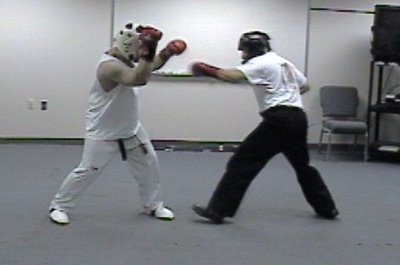This was originally posted in October 2004. I thought we could all use it, so I am re-posting it.
 What is an effective lead? It…
What is an effective lead? It…
- Closes the gap quickly
- Closes the gap safely by placing the weapon between the lead-off and counter fighter.
- Forces a reaction, thereby creating an opening or setting up another technique to score.
What are some examples of poor lead techniques?
Backfist (depending on how it’s thrown
Hooking punches
Rear-hand techniques (depending on how thrown
Front or rear-leg Roundhouse kick (depending…)
Rear leg side kick
Most other rear-leg kicks
Most front kicks (I haven’t figured how to make it a good lead technique)
Spinning techniques and most jumping techniques.
What are some examples of good techniques?
Jab
Backfist, if it’s chambered properly
Lead right, as long as the weapon moves first
Front-leg side kick
Front-leg hook or side kicks, if chambered properly
How do you perform a lead which closes the gap quickly?
- Technique moves before the body – this leads to a perceived increase in speed. The technique begins before the footwork, and a small part of the body moves much more quickly than the body as a whole. It is easier to perceive the whole body moving than the hand or foot alone. Move it first!
- Use the shortest distance to the target with the closest weapon. This usually means the lead hand or foot is the fastest and safest lead.
Keep the weapon in constant, slight motion. This means, when punching as a lead, keep the lead hand moving a little and if kicking, constant footwork.
How do you perform a lead which closes the gap safely?
- Make sure that it’s aimed at the opponent at the beginning, on the way in, and the way out.
- Keep the lead between you and your opponent.
How do you perform a lead which forces a reaction, thereby creating an opening or setting up another technique to score?
- Commit the technique such that the counter-fighter is forced to defend it, run or get hit. This cannot be over-emphasized. This forces the counter fighter to handle defending you rather than countering you.
- Aim the technique to an area that is open, or undefended. If a target isn’t open, it’s already defended and leaves the lead-off fighter vulnerable to attack.
One technique can set up another. Typical examples of this are going low, then high; inside, then outside, and the reverse of these. - Lead to cover the eyes. That creates openings by slowing the reaction of the counter-fighter because he can’t see. It creates opening by the distraction as well.
Lead hard into the guard of your opponent. - Use a very committed attack to your opponent’s arms or into his legs as he blocks. This could stun the attacker or knock him off balance. Damaging the weapon is a valid tactic and can prove very distracting and create openings.

No comments:
Post a Comment